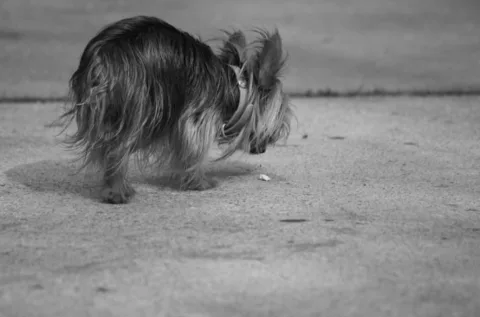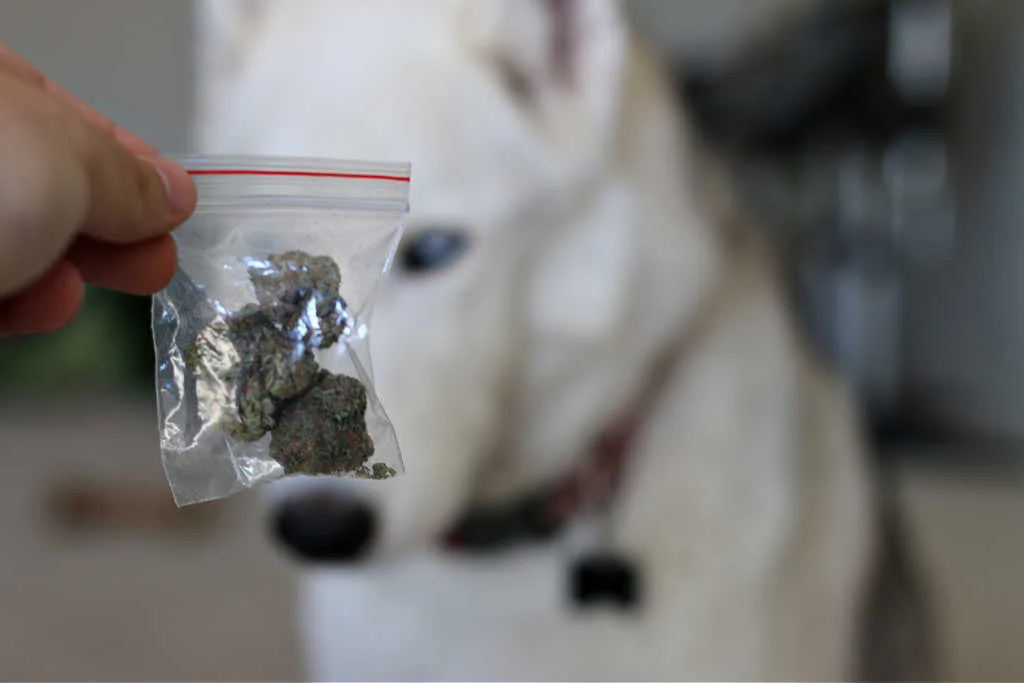It should come as no surprise to anyone that a dog might eat a cigarette butt — or some other kind of tobacco product.
Dogs might find them appealing — because many tobacco products smell like food:
- Cigarettes have flavors such as mint, for example.
- Chewing tobaccos come in wintergreen, peach, apple and butternut flavors
- Nicotine gums are commonly mint or orange flavored.
The problem is that cigarette butts (and all tobacco products) have an ingredient that is very dangerous to pets — especially dogs. That ingredient is nicotine.
In reality, nicotine is toxic for humans too. That sick and nauseous feeling you get the very first time you take a drag off of a cigarette is actually because you have nicotine poisoning.
While our human bodies over time can build up a tolerance to the toxic nature of nicotine, dogs don’t have that ability. Even if a dog eats only 1 or 2 cigarette butts, it can kill them.
I have heard some people claim that cigarette butts are not harmful to dogs, but I’ve seen nicotine poisoning of a dog firsthand — and it’s not pretty!
How Much Nicotine Is Too Much For Dogs?
It only takes 0.5 mg of nicotine per 1 pound of pet weight to be toxic, and 10 mg per pound can be lethal.
The toxic dose for nicotine in pets is 0.5 to 1 mg per pound of pet body weight while the lethal dose is 4 mg per pound of pet body weight. So how does this translate to nicotine containing products? A cigarette contains between 9 and 30 mg of nicotine depending on the type of cigarette. When the cigarette is smoked, the nicotine concentrates down in the oral end meaning that a small nub of a cigarette butt will retain 25% of the nicotine contained in the original cigarette. Smoking a cigarette yields 0.5 to 2 mg of nicotine to the smoker, but eating the cigarette (or other nicotine product) is a whole different ballgame as all of the nicotine becomes available for absorption into the body! —Veterinary Information Network
As an example… if a small dog weighs under 10 pounds and a cigarette butt contains 2 to 7 mg of nicotine, you can see how a eating even a couple of cigarette butts could be fatal!
In fact:
- A 20 lb dog would only need 10 mg of nicotine to become poisoned (2 to 5 cigarette butts)
- A 40 lb dog would only need 1 cc of e-juice to become poisoned (that’s less than a quarter teaspoon!)
The biggest problem with cigarette butts is that much of the nicotine was drawn into the filter when a person smoked that cigarette — so cigarette butts have a high concentration of the nicotine.
Here are the nicotine content numbers you need to know:
- 1 cigarette contains 9 to 30 mg of nicotine.
- 1 e-cigarette cartridge contains 6 to 24 mg of nicotine.
- 1 cigar contains 15 to 40 mg of nicotine.
- 1 nicotine inhaler contains 10 mg of nicotine per cartridge.
- 1 nicotine nasal spray bottle contains 80 to 100 mg of nicotine per bottle.
- 1 gram of chewing tobacco (aka “dip” or “chew”) contains 12 to 17 mg of nicotine.
- 1 nicotine patch contains 8 to 114 mg of nicotine.
- 1 piece of nicotine gum contains 2 to 4 mg of nicotine.
As for electronic cigarettes (or e-cigs)… the nicotine levels in these e-liquids can vary in concentration from being completely nicotine-free up to 36 milligrams per milliliter (mg/mL) of nicotine. For marketing purposes, the “/mL” part is frequently dropped, and the e-liquids are advertised as having X mg of nicotine rather than X mg/mL. In some e-cigs, the user controls the amount of nicotine delivered by adjusting the flow of e-liquid from the cartridge. An e-cig with a full cartridge can contain up to 36 mg of nicotine … Even more dangerous are the bottles of e-liquid that are used to recharge the e-cig cartridge. The nicotine in these bottles can range from 10 mL to 60 mL or more. So a 30-mL bottle of 36 mg/mL e-liquid will contain 1080 mg of nicotine — more than enough to prove fatal for even a very large dog if the contents are ingested. —Veterinary Information Network
12 Signs Of Nicotine Poisoning In Dogs
Here are some symptoms of nicotine poisoning in pets to watch for if you think your dog has eaten a cigarette butt:
- Gastrointestinal symptoms: 1) vomiting; 2) an overproduction of saliva; 3) diarrhea; 4) abdominal pain
- Cardiovascular symptoms: 1) hypertension; 2) abnormal heart rate
- Neurological symptoms: 1) lack of coordination with the legs, head, torso — or all three; 2) weakness or lethargy; 3) large pupils; 4) seizures
- Pulmonary symptoms: 1) rapid breathing; 2) followed by slow and ineffective breathing
Keep in mind that some of these symptoms can be true of other types of poisoning as well.
Tobacco products can be fatal to pets, if ingested. Signs of poisoning develop within 15 to 45 minutes and include excitation, salivation, vomiting, and diarrhea. Pets may develop seizures, collapse and die from cardiac arrest. Keep cigarettes, cigars, tobacco, nicotine gum and patches, and ashtrays out of the reach of pets. Empty ashtrays frequently — since cigarette butts contain about 25% of the total nicotine in a cigarette. — Drs. Foster & Smith
Should You Take A Dog Without Symptoms To The Vet?
Remember, symptoms of nicotine poisoning in dogs start 15 to 45 minutes after ingesting the nicotine.
If your dog hasn’t eaten an entire cigarette butt (or you caught them and took the cigarette butt away), then they will most likely be okay. That is, unless your dog is a very small size or teacup variety. In that case, you should take your dog to see a veterinarian right away.
If your dog has eaten one or more cigarette butts (or you think they may have), then use the nicotine content numbers listed above and your dog’s weight to determine if you should call your vet. If so, and it’s after hours or on a weekend, it’s best to take your dog to an emergency pet clinic.
Be sure to keep cigarette butts and other nicotine products out of your dog’s reach!
Is Marijuana Toxic To Dogs?
No — but the result of ingesting marijuana (cannabis) is not the same for all dogs. A small amount may affect one dog more than another. Marijuana toxicity in dogs depends mostly on the dog’s age, size, and overall health.
Cannabis intoxication in dogs is seldom fatal. The average marijuana cigarette contains about 150 mg of THC. The minimum lethal oral dose of THC in pets is fairly high. However, deaths have been noted after ingestion of foods containing highly concentrated cannabis — such as medical-grade THC. In fact, fatalities were very rare until the development of medical-grade products. —VCA Hospitals
If your dog has eaten a stash of marijuana, you have anywhere from 30 to 90 minutes to induce vomiting — because that’s how long it usually takes for your dog to start showing signs of toxicity.
Signs include incoordination and listlessness along with dilated pupils, slow heart rate and sometimes urinary incontinence. A characteristic startle reaction has been described where the pet appears drowsy and even may begin to fall over but catches balance. Marijuana toxicity can look similar to intoxication with numerous other sedatives, but the most serious consideration is anti-freeze poisoning — which looks similar in its early stages and is usually fatal if not diagnosed early. —Veterinary Information Network
Once your dog has started showing signs, it is no longer safe to induce vomiting.
In that case, liquid activated charcoal from your vet (or emergency vet clinic) is the only treatment option that works!
The bottom line is there is not an official “safe level” of exposure to marijuana for dogs — and the effects of marijuana ingestion can last for several days.
It is very important for all the relevant exposure information to be given to the veterinarian if the pet is to be helped. Veterinarians are not obligated to report anything to local police. If you know marijuana was involved in an intoxication you must tell the attending doctor. Obviously this goes for other recreational drugs as well. —Veterinary Partner
And while we’re in the partying mode, here’s what you need to know about dogs and alcohol.







